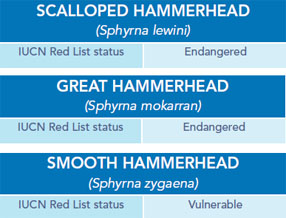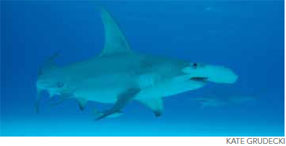Protecting Hammerheads at IATTC
The Inter-American Tropical Tuna Commission (IATTC) will hold its 82nd annual meeting in La Jolla, California from July 4-8, 2011. The IATTC is one of five Regional Fisheries Management Organizations (RFMOs) established to manage fishing of tuna and tuna-like species. However, with the entry into force of the Antigua Convention in September 2010, the mandate of the IATTC has been updated to include an emphasis on implementing the ecosystem approach and precautionary principle in management decisions. This mandate offers the IATTC a critical opportunity to adequately address bycatch concerns and significantly reduce tuna fishing impacts on the ecosystem and on non-tuna species in the convention area such as sharks.
Reasons to support a prohibition on retention by IATTC fisheries
- Hammerhead sharks are targeted for their highly valued fins and are also caught as bycatch.
- Hammerhead shark meat is generally not consumed.

- They have some of the lowest recovery potentials in comparison to other shark species, which makes them even more susceptible to extinction.
- Hammerhead sharks, caught both in the longline and purse seine fisheries, are among the top shark species caught in the eastern Pacific Ocean.1
- Their distinct body shape makes them easy to identify as a genus, but fishermen have trouble identifying between different hammerhead species.
- The lack of classification to the species level in catch data results in an inability to accurately assess the status of the various species.
- According to the catch data that is available, the catch of hammerheads in the Pacific has gone down drastically in recent years-- this is most likely attributed to decreases in population size due to fishing pressure.
- Hammerheads are one of the few shark species that school, making them easier to target.
- Reports have also shown hammerhead juveniles are increasingly being targeted.2
Biological vulnerability to overexploitation
- Low reproductive capacity, with average litters of 14 to 26 pups.
- Slow intrinsic population growth in comparison with other species of sharks.
- Long gestation period of eight to 12 months.
- Long reproductive periodicity, reproducing only every two years.
Scalloped hammerhead fisheries and trade
The scalloped hammerhead shark, one of the most distinctive creatures on the planet, is subject to targeted fisheries, illegal fishing and fishery bycatch throughout the world.  Unlike other species of sharks, hammerheads frequently aggregate in large numbers, which makes them more vulnerable to fishing efforts.3 Furthermore, according to a 2008 assessment of illegal, unreported and unregulated fishing, hammerheads are among the most frequently taken shark species in illegal fishing.4
Unlike other species of sharks, hammerheads frequently aggregate in large numbers, which makes them more vulnerable to fishing efforts.3 Furthermore, according to a 2008 assessment of illegal, unreported and unregulated fishing, hammerheads are among the most frequently taken shark species in illegal fishing.4
Species-specific trade data are limited, but marketbased scientific inquiries have yielded important trade information.5 Traders have stated that hammerhead fins are some of the most valuable in the market.6 The three hammerhead species (Sphyrna lewini, S. mokarran, S. zygaena) combined make up approximately 6 percent of the identified fins entering the Hong Kong market.7 From this information, scientists have estimated that 1.3 million to 2.7 million scalloped and smooth hammerheads are exploited for the fin trade every year.8
Conclusion
The scalloped hammerhead, along with the lookalike species: great and smooth hammerheads, were proposed for a CITES Appendix II listing last year that would have regulated international trade of these species, but the proposal fell short, with many countries arguing that sharks should be regulated through RFMOs instead of CITES. As a result, the Commission should protect these vulnerable species by prohibiting the retention of hammerheads in all fisheries in the Convention area and requesting the immediate live release of any hammerhead shark.
References
1. M. Román-Verdesoto and M. Orozco-Zöller, “Bycatches of sharks in the tuna purse-seine fishery of the eastern Pacific Ocean reported by observers of the Inter-American Tropical Tuna Commission, 1993-2004,” Inter-American Tropical Tuna Commission Data Report 11, La Jolla, CA, 2005. http://www.iattc.org/PDFFiles2/DataReports/Data-Report-11.pdf>.
2. Convention of International Trade in Endangered Species of Wild Fauna and Flora, “Consideration of Proposals for Amendment of Appendices I and II: Proposal 15,” Fifteenth meeting of the Conference of the Parties, Doha (Qatar), 13-25 March 2010. http://cites.org/eng/cop/15/prop/E-15-Prop-15.pdf>. Downloaded 21 December 2009.
3. J. Baum et al., Sphyrna lewini (2007). In: IUCN 2009, IUCN Red List of Threatened Species, Version 2009.2, www.iucnredlist.org>. Downloaded 15 December 2009.
4. M. Lack and G. Sant, “Illegal, unreported and unregulated shark catch: A review of current knowledge and action,” Department of the Environment, Water, Heritage and the Arts and TRAFFIC, Canberra, www.traffic.org/species-reports/traffic_species_fish30.pdf>.
5. S. Clarke, “Use of shark fin trade data to estimate historic total shark removals in the Atlantic Ocean,” Aquatic Living Resources, 21:373-81, (2008), www.alr-journal.org/index.php?option=toc&url=/articles/alr/abs/2008/04/contents/contents.html>.
6. D. L. Abercrombie et al., “Global-scale genetic identification of hammerhead sharks: Application to assessment of the international
fin trade and law enforcement,” Conservation Genetics, 6:775–88,www.springerlink.com/content/k13n380815h59q11/?p=db3caf027f654ee294d73ac44b1e7e80&pi=2>.
7. S. C. Clarke et al., “Global Estimates of Shark Catches Using Trade Records From Commercial Markets,” Ecology Letters, 9:1115–26,
8. S. C. Clarke et al., “Identification of Shark Species Composition and Proportion in the Hong Kong Shark Fin Market Based on Molecular Genetics and Trade Records,” Conservation Biology 20(1):201-11 (2006), www3.interscience.wiley.com/cgi-bin/fulltext/118564070/PDFSTART>.






